#VLSI
Explore tagged Tumblr posts
Text
Lynn Conway passed away this weekend. She was an electrical engineer whose professional work was instrumental in enabling virtually all modern semiconductor devices. She was fired from IBM, and lost her family for transitioning, and later came out and became an outspoken transgender activist.
Rest Easy, Lynn, the world is less for your absence.

2K notes
·
View notes
Note
What are some of the coolest computer chips ever, in your opinion?
Hmm. There are a lot of chips, and a lot of different things you could call a Computer Chip. Here's a few that come to mind as "interesting" or "important", or, if I can figure out what that means, "cool".
If your favourite chip is not on here honestly it probably deserves to be and I either forgot or I classified it more under "general IC's" instead of "computer chips" (e.g. 555, LM, 4000, 7000 series chips, those last three each capable of filling a book on their own). The 6502 is not here because I do not know much about the 6502, I was neither an Apple nor a BBC Micro type of kid. I am also not 70 years old so as much as I love the DEC Alphas, I have never so much as breathed on one.
Disclaimer for writing this mostly out of my head and/or ass at one in the morning, do not use any of this as a source in an argument without checking.
Intel 3101
So I mean, obvious shout, the Intel 3101, a 64-bit chip from 1969, and Intel's first ever product. You may look at that, and go, "wow, 64-bit computing in 1969? That's really early" and I will laugh heartily and say no, that's not 64-bit computing, that is 64 bits of SRAM memory.
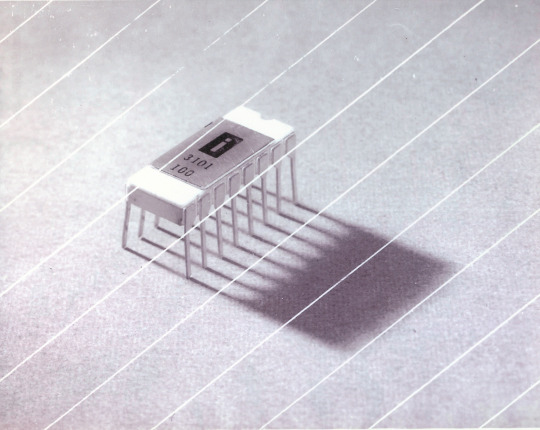

This one is cool because it's cute. Look at that. This thing was completely hand-designed by engineers drawing the shapes of transistor gates on sheets of overhead transparency and exposing pieces of crudely spun silicon to light in a """"cleanroom"""" that would cause most modern fab equipment to swoon like a delicate Victorian lady. Semiconductor manufacturing was maturing at this point but a fab still had more in common with a darkroom for film development than with the mega expensive building sized machines we use today.
As that link above notes, these things were really rough and tumble, and designs were being updated on the scale of weeks as Intel learned, well, how to make chips at an industrial scale. They weren't the first company to do this, in the 60's you could run a chip fab out of a sufficiently well sealed garage, but they were busy building the background that would lead to the next sixty years.
Lisp Chips
This is a family of utterly bullshit prototype processors that failed to be born in the whirlwind days of AI research in the 70's and 80's.
Lisps, a very old but exceedingly clever family of functional programming languages, were the language of choice for AI research at the time. Lisp compilers and interpreters had all sorts of tricks for compiling Lisp down to instructions, and also the hardware was frequently being built by the AI researchers themselves with explicit aims to run Lisp better.
The illogical conclusion of this was attempts to implement Lisp right in silicon, no translation layer.
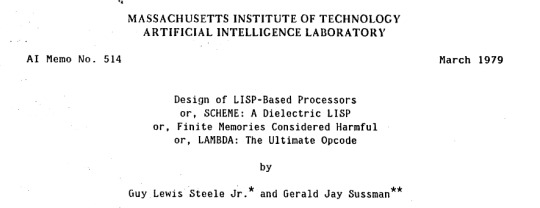
Yeah, that is Sussman himself on this paper.
These never left labs, there have since been dozens of abortive attempts to make Lisp Chips happen because the idea is so extremely attractive to a certain kind of programmer, the most recent big one being a pile of weird designd aimed to run OpenGenera. I bet you there are no less than four members of r/lisp who have bought an Icestick FPGA in the past year with the explicit goal of writing their own Lisp Chip. It will fail, because this is a terrible idea, but damn if it isn't cool.
There were many more chips that bridged this gap, stuff designed by or for Symbolics (like the Ivory series of chips or the 3600) to go into their Lisp machines that exploited the up and coming fields of microcode optimization to improve Lisp performance, but sadly there are no known working true Lisp Chips in the wild.
Zilog Z80
Perhaps the most important chip that ever just kinda hung out. The Z80 was almost, almost the basis of The Future. The Z80 is bizzare. It is a software compatible clone of the Intel 8080, which is to say that it has the same instructions implemented in a completely different way.
This is, a strange choice, but it was the right one somehow because through the 80's and 90's practically every single piece of technology made in Japan contained at least one, maybe two Z80's even if there was no readily apparent reason why it should have one (or two). I will defer to Cathode Ray Dude here: What follows is a joke, but only barely

The Z80 is the basis of the MSX, the IBM PC of Japan, which was produced through a system of hardware and software licensing to third party manufacturers by Microsoft of Japan which was exactly as confusing as it sounds. The result is that the Z80, originally intended for embedded applications, ended up forming the basis of an entire alternate branch of the PC family tree.
It is important to note that the Z80 is boring. It is a normal-ass chip but it just so happens that it ended up being the focal point of like a dozen different industries all looking for a cheap, easy to program chip they could shove into Appliances.
Effectively everything that happened to the Intel 8080 happened to the Z80 and then some. Black market clones, reverse engineered Soviet compatibles, licensed second party manufacturers, hundreds of semi-compatible bastard half-sisters made by anyone with a fab, used in everything from toys to industrial machinery, still persisting to this day as an embedded processor that is probably powering something near you quietly and without much fuss. If you have one of those old TI-86 calculators, that's a Z80. Oh also a horrible hybrid Z80/8080 from Sharp powered the original Game Boy.
I was going to try and find a picture of a Z80 by just searching for it and look at this mess! There's so many of these things.
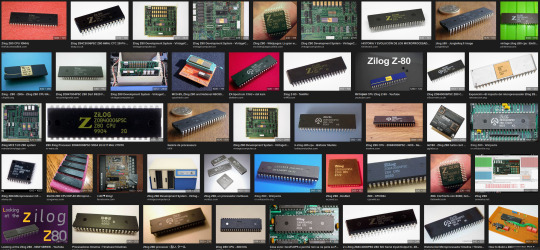
I mean the C/PM computers. The ZX Spectrum, I almost forgot that one! I can keep making this list go! So many bits of the Tech Explosion of the 80's and 90's are powered by the Z80. I was not joking when I said that you sometimes found more than one Z80 in a single computer because you might use one Z80 to run the computer and another Z80 to run a specialty peripheral like a video toaster or music synthesizer. Everyone imaginable has had their hand on the Z80 ball at some point in time or another. Z80 based devices probably launched several dozen hardware companies that persist to this day and I have no idea which ones because there were so goddamn many.
The Z80 eventually got super efficient due to process shrinks so it turns up in weird laptops and handhelds! Zilog and the Z80 persist to this day like some kind of crocodile beast, you can go to RS components and buy a brand new piece of Z80 silicon clocked at 20MHz. There's probably a couple in a car somewhere near you.
Pentium (P6 microarchitecture)
Yeah I am going to bring up the Hackers chip. The Pentium P6 series is currently remembered for being the chip that Acidburn geeks out over in Hackers (1995) instead of making out with her boyfriend, but it is actually noteworthy IMO for being one of the first mainstream chips to start pulling serious tricks on the system running it.

The P6 microarchitecture comes out swinging with like four or five tricks to get around the numerous problems with x86 and deploys them all at once. It has superscalar pipelining, it has a RISC microcode, it has branch prediction, it has a bunch of zany mathematical optimizations, none of these are new per se but this is the first time you're really seeing them all at once on a chip that was going into PC's.
Without these improvements it's possible Intel would have been beaten out by one of its competitors, maybe Power or SPARC or whatever you call the thing that runs on the Motorola 68k. Hell even MIPS could have beaten the ageing cancerous mistake that was x86. But by discovering the power of lying to the computer, Intel managed to speed up x86 by implementing it in a sensible instruction set in the background, allowing them to do all the same clever pipelining and optimization that was happening with RISC without having to give up their stranglehold on the desktop market. Without the P5 we live in a very, very different world from a computer hardware perspective.
From this falls many of the bizzare microcode execution bugs that plague modern computers, because when you're doing your optimization on the fly in chip with a second, smaller unix hidden inside your processor eventually you're not going to be cryptographically secure.
RISC is very clearly better for, most things. You can find papers stating this as far back as the 70's, when they start doing pipelining for the first time and are like "you know pipelining is a lot easier if you have a few small instructions instead of ten thousand massive ones.
x86 only persists to this day because Intel cemented their lead and they happened to use x86. True RISC cuts out the middleman of hyperoptimizing microcode on the chip, but if you can't do that because you've girlbossed too close to the sun as Intel had in the late 80's you have to do something.
The Future
This gets us to like the year 2000. I have more chips I find interesting or cool, although from here it's mostly microcontrollers in part because from here it gets pretty monotonous because Intel basically wins for a while. I might pick that up later. Also if this post gets any longer it'll be annoying to scroll past. Here is a sample from a post I have in my drafts since May:

I have some notes on the weirdo PowerPC stuff that shows up here it's mostly interesting because of where it goes, not what it is. A lot of it ends up in games consoles. Some of it goes into mainframes. There is some of it in space. Really got around, PowerPC did.
235 notes
·
View notes
Text
Lynn Ann Conway passed.
Lynn Conway passed on 2024-06-09, aged 86, at home in Jackson, MI. She was professor of EE & CS; engineering explorer, human empowerment advocate. She was transgender activist, the inventor of dynamic instruction handling and the initiator of Mead–Conway #VLSI chip design revolution. R.I.P. 🌻
2 notes
·
View notes
Text
youtube
Use this trick to Save time : HDL Simulation through defining clock
Why is this trick useful? Defining a clock in your simulation can save you time during simulation because you don't have to manually generate the clock signal in your simulation environment. Wanted to know how to define and force clock to simulate your digital system. Normally define clock used to simulate system with clock input. But I am telling you this trick for giving values to input ports other than clock. It will help you to save time in simulation because you do not need to force values to input ports every time. Lets brief What we did - gave some clock frequency to input A, like we gave 100. Than we made Half the frequency of clock to 50 and gave it to Input B. In similar way if we have 3rd input too we goanna half the frequency again to 25 and would give to next input.
Subscribe to "Learn And Grow Community"
YouTube : https://www.youtube.com/@LearnAndGrowCommunity
LinkedIn Group : https://www.linkedin.com/groups/7478922/
Blog : https://LearnAndGrowCommunity.blogspot.com/
Facebook : https://www.facebook.com/JoinLearnAndGrowCommunity/
Twitter Handle : https://twitter.com/LNG_Community
DailyMotion : https://www.dailymotion.com/LearnAndGrowCommunity
Instagram Handle : https://www.instagram.com/LearnAndGrowCommunity/
Follow #LearnAndGrowCommunity
#HDL Design#Digital Design#Verilog#VHDL#FPGA#Digital Logic#Project#Simulation#Verification#Synthesis#B.Tech#Engineering#Tutorial#Embedded Systesm#VLSI#Chip Design#Training Courses#Software#Windows#Certification#Career#Hardware Design#Circuit Design#Programming#Electronics Design#ASIC#Xilinx#Altera#Engineering Projects#Engineering Training Program
2 notes
·
View notes
Text
The Future of Semiconductors: Unveiling a World of Possibilities
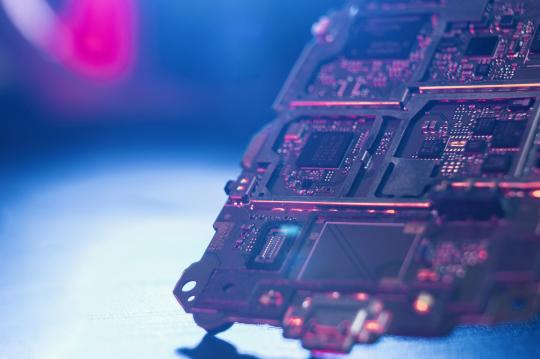
**The Future of Semiconductors: Unveiling a World of Possibilities**
As we stand on the brink of a new era, the semiconductor industry finds itself at the heart of a technological revolution. The impact of semiconductors on our lives has been profound, driving advancements across industries and shaping the very fabric of our modern civilization. But what lies ahead for this dynamic and transformative field? Let's delve into the future of semiconductors and the boundless possibilities that await us.
**1. Quantum Leap in Computing:**
The race towards quantum computing is intensifying, and semiconductors will play a pivotal role in unlocking its true potential. Quantum processors, built on novel semiconductor materials, have the power to process vast amounts of data in a fraction of the time it takes traditional computers. The future of computing will transcend current limitations, empowering us to solve complex problems previously deemed insurmountable.
**2. AI and Machine Learning:**
The era of artificial intelligence is upon us, and semiconductors will serve as the backbone of AI and machine learning applications. With the growing demand for AI-driven technologies in autonomous vehicles, robotics, healthcare, and more, the semiconductor industry is set to witness an unprecedented surge in AI-focused chip designs. Neuromorphic computing, inspired by the human brain's architecture, could unlock revolutionary AI capabilities, paving the way for cognitive computing and self-learning systems.
**3. The Internet of Things (IoT) Revolution:**
As IoT proliferates, the demand for energy-efficient and high-performance semiconductor devices will skyrocket. We envision a future where billions of interconnected devices communicate seamlessly, facilitated by advanced semiconductor technologies. Ultra-low-power processors, sensors, and wireless communication chips will define the landscape of the IoT revolution, shaping smart cities, wearables, and an interconnected world.
**4. Green and Sustainable Semiconductors:**
Sustainability will be a driving force in the semiconductor industry's future. Innovations in materials and manufacturing processes will lead to environmentally friendly and energy-efficient semiconductor solutions. From eco-friendly chip packaging to renewable energy-powered fabs, the industry will strive to minimize its carbon footprint, contributing to a greener tomorrow.
**5. Silicon Photonics and Beyond:**
The integration of photonics with silicon promises a new era of ultra-high-speed data transmission and processing. Silicon photonics will revolutionize data centers, enabling faster communication between chips and reducing data bottlenecks. Moreover, emerging technologies like 2D materials and carbon nanotubes offer exciting possibilities for futuristic semiconductor devices that could outperform traditional silicon-based chips.
**6. Security and Privacy:**
With the increasing dependence on connected devices, security and privacy will be paramount. Future semiconductor designs will prioritize hardware-based security features to protect against cyber threats and safeguard sensitive data. Trusted execution environments and secure enclaves will become integral components of semiconductor devices, ensuring user confidence in an interconnected world.
**7. Global Collaboration and Talent Development:**
The future of semiconductors will thrive on global collaboration and talent development. International partnerships will foster innovation, as countries pool their resources and expertise. Companies will invest in nurturing a diverse and skilled workforce, driving advancements and promoting a culture of inclusion and creativity.
The future of semiconductors is bright, brimming with possibilities that have the potential to redefine our world. As innovators, engineers, and visionaries, let's embrace this transformative journey together. Let's harness the power of semiconductors to build a future that empowers, connects, and inspires generations to come.
*The future is here, and it's in the hands of those who dare to dream and innovate with semiconductors as their guiding light.*
2 notes
·
View notes
Text
I started the vlsi book twice. Eventually I'll get through it.
Rest in peace

Goodbye, Lynn. Thank you for your constant support and encouragement since the day I started these comics. It has meant the world to me, and I wish I could have told you. We will remember you forever.
64K notes
·
View notes
Text
Top Hardware Design Companies in India – Innovative & Reliable Solutions
Looking for the top hardware design companies in India Discover industry leaders offering cutting-edge PCB design, embedded systems, VLSI, and IoT solutions for various industries. These companies specialize in delivering high-performance, cost-effective, and scalable hardware solutions tailored to your business needs. Stay ahead with expert hardware development and seamless integration.

0 notes
Text

Engineering Project Consultancy: Turning Ideas into Reality
Engineering students often struggle to find the right guidance for their academic projects. That’s where engineering project consultancy services come in! These consultancies provide expert support in various domains, including CSE, EEE, VLSI, Embedded Systems, and MATLAB.
Why Choose a Project Consultancy?
✅ Expert Guidance – Get mentorship from experienced professionals. ✅ Customized Solutions – Projects tailored to your requirements. ✅ Hands-on Learning – Gain practical experience with real-time implementation. ✅ Time-Saving – Focus on learning while experts help with the technical complexities.
If you're a student in Tirupati looking for professional project assistance, our consultancy at Takeoff Projects is here to help! 🚀
0 notes
Text
0 notes
Text
Understand the key differences between embedded systems, VLSI, and PCB designing, focusing on their applications, processes, and unique design challenges.
0 notes
Note
Hello. So what's the deal with computer chips? Let's say, for example, that I wanted to build a brand new Sega Genesis. Ignoring firmware and software, what's stopping me from dissecting their proprietary chips and reverse-engineering them to make new ones? It's just electric connections and such inside, isn't it? If I match the pin ins and outs, shouldn't it be easy? So why don't people do it?
The answer is that people totally used to do this, there's several examples of chips being cloned and used to build compatible third-party hardware, the most famous two examples being famiclones/NESclones and Intel 808X clones.
AMD is now a major processor manufacturer, but they took off in the 70's by reverse-engineering Intel's 8080 processor. Eventually they were called in to officially produce additional 8086 chips under license to meet burgeoning demand for IBM PC's, but that was almost a decade later if I remember correctly.
There were a ton of other 808X clones, like the Soviet-made pin-compatible K1810VM86. Almost anyone with a chip fab was cloning Intel chips back in the 80's, a lot of it was in the grey area of reverse engineering the chips.

Companies kept cloning Intel processors well into the 386 days, but eventually the processors got too complicated to easily clone, and so only companies who licensed designs could make them, slowly reducing the field down to Intel, AMD, and Via, who still exist! Via's CPU division currently works on the Zhaoxin x86_64 processors as part of the ongoing attempts to homebrew a Chinese-only x86 processor.
I wrote about NES clones a while ago, in less detail, so here's that if you want to read it:
Early famiclones worked by essentially reverse-engineering or otherwise cloning the individual chips inside an NES/famicom, and just reconstructing a compatible device from there. Those usually lacked any of the DRM lockout chips built into the original NES, and were often very deeply strange, with integrated clones of official peripherals like the keyboard and mouse simply hardwired directly into the system.
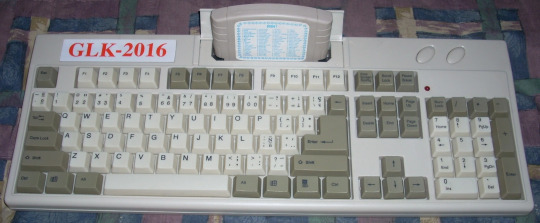
These were sold all over the world, but mostly in developing economies or behind the Iron Curtain where official Nintendo stuff was harder to find. I had a Golden China brand Famiclone growing up, which was a common famiclone brand around South Africa.
Eventually the cost of chip fabbing came down and all those individual chips from the NES were crammed onto one cheap piece of silicon and mass produced for pennies each, the NES-on-a-chip. With this you could turn anything into an NES, and now you could buy a handheld console that ran pirated NES game for twenty dollars in a corner store. In 2002. Lots of edutainment mini-PC's for children were powered by these, although now those are losing out to Linux (and now Android) powered tablets a la Leapfrog.
Nintendo's patents on their hardware designs expired throughout the early 2000's and so now the hardware design was legally above board, even if the pirated games weren't. You can still find companies making systems that rely on these NES chips, and there are still software houses specializing in novel NES games.
Why doesn't this really happen anymore? Well, mostly CPU's and their accoutrements are too complicated. Companies still regularly clone their competitors simpler chips all the time, and I actually don't know if Genesis clones exist, it's only a Motorola 68000k, but absolutely no one is cloning a modern Intel or AMD processor.

The die of a Motorola 68000 (1979)
A classic Intel 8080 is basically the kind of chip you learn about in entry level electrical engineering, a box with logic gates that may be complicated, but pretty straightforwardly fetches things from memory, decodes, executes, and stores. A modern processor is a magic pinball machine that does things backwards and out of order if it'll get you even a little speedup, as Mickens puts it in The Slow Winter:
I think that it used to be fun to be a hardware architect. Anything that you invented would be amazing, and the laws of physics were actively trying to help you succeed. Your friend would say, “I wish that we could predict branches more accurately,” and you’d think, “maybe we can leverage three bits of state per branch to implement a simple saturating counter,” and you’d laugh and declare that such a stupid scheme would never work, but then you’d test it and it would be 94% accurate, and the branches would wake up the next morning and read their newspapers and the headlines would say OUR WORLD HAS BEEN SET ON FIRE. You’d give your buddy a high-five and go celebrate at the bar, and then you’d think, “I wonder if we can make branch predictors even more accurate,” and the next day you’d start XOR’ing the branch’s PC address with a shift register containing the branch’s recent branching history, because in those days, you could XOR anything with anything and get something useful, and you test the new branch predictor, and now you’re up to 96% accuracy, and the branches call you on the phone and say OK, WE GET IT, YOU DO NOT LIKE BRANCHES, but the phone call goes to your voicemail because you’re too busy driving the speed boats and wearing the monocles that you purchased after your promotion at work. You go to work hung-over, and you realize that, during a drunken conference call, you told your boss that your processor has 32 registers when it only has 8, but then you realize THAT YOU CAN TOTALLY LIE ABOUT THE NUMBER OF PHYSICAL REGISTERS, and you invent a crazy hardware mapping scheme from virtual registers to physical ones, and at this point, you start seducing the spouses of the compiler team, because it’s pretty clear that compilers are a thing of the past, and the next generation of processors will run English-level pseudocode directly.

Die shot of a Ryzen 5 2600 core complex (2019)
Nowadays to meet performance parity you can't just be pin-compatible and run at the right frequency, you have to really do a ton of internal logical optimization that is extremely opaque to the reverse engineer. As mentioned, Via is making the Zhaoxin stuff, they are licensed, they have access to all the documentation needed to make an x86_64 processor, and their performance is still barely half of what Intel and AMD can do.
Companies still frequently clone each others simpler chips, charge controllers, sensor filters, etc. but the big stuff is just too complicated.
182 notes
·
View notes
Text
Explore the World of Semiconductor Courses Online: Digital VLSI SoC Design and Planning
The rapid advancement of technology has brought semiconductors to the forefront of innovation, powering everything from smartphones to advanced computing systems. For those looking to dive deep into this field, pursuing semiconductor courses online is a strategic move, particularly in areas like Digital VLSI (Very Large Scale Integration) and SoC (System on Chip) Design and Planning.
Why Choose Semiconductor Courses Online?
The semiconductor industry is the backbone of modern electronics, and with the growing demand for smaller, faster, and more efficient devices, expertise in semiconductor design is highly sought after. Online courses provide flexibility, allowing you to learn at your own pace while gaining valuable skills that are directly applicable in the industry.
Course Overview: Digital VLSI SoC Design and Planning
The "Digital VLSI SoC Design and Planning" course on FutureSkills Prime is designed for professionals and students eager to deepen their knowledge in semiconductor design. This course covers the essential aspects of VLSI and SoC design, focusing on both theoretical concepts and practical applications.
Key Highlights:
In-Depth Learning: The course delves into the intricacies of digital VLSI design, providing a comprehensive understanding of SoC architecture, design methodologies, and planning.
Industry-Relevant Skills: You’ll learn the latest techniques and tools used in the industry, ensuring that your skills remain relevant and up-to-date.
Practical Applications: The course includes hands-on projects that simulate real-world challenges, helping you apply your knowledge effectively.
Benefits of Taking This Course
Enrolling in this course offers numerous advantages, particularly for those pursuing careers in semiconductor design. Here’s what you can expect:
Career Advancement: With the semiconductor industry booming, the skills acquired through this course can open doors to various high-paying roles in design and development.
Flexibility: As an online course, it allows you to balance learning with other commitments, making it ideal for working professionals.
Certification: Upon completion, you’ll receive a certification that can enhance your resume and demonstrate your expertise to potential employers.
Conclusion
If you’re looking to excel in the semiconductor industry, enrolling in the "Digital VLSI SoC Design and Planning" course on FutureSkills Prime is a smart choice. This course, one of the top semiconductor courses online, equips you with the knowledge and skills needed to thrive in a rapidly evolving field. Take the next step in your career and explore the possibilities that this course has to offer.
0 notes
Text
In this blog post, we will go over the implementation of interrupt handling in the UVM Test bench(TB) environment.
0 notes
Text

VLSI SYSTEM DESIGN-Youngminds
VLSI (Very Large Scale Integration) system design is the cornerstone of modern electronic devices, enabling the creation of intricate integrated circuits that power everything from smartphones to supercomputers. At Youngminds, we offer cutting-edge VLSI system design services to meet the demands of today's technology-driven world.
Youngminds team has experienced engineers specializes in designing highly efficient and reliable VLSI systems tailored to our clients' specific needs. Youngminds leverage the latest advancements in semiconductor technology, design methodologies, and tools to deliver innovative solutions that optimize performance, power consumption, and cost-effectiveness.
From concept to fabrication, we provide comprehensive support throughout the entire design process, ensuring seamless integration and functionality. Our expertise spans a wide range of applications, including digital signal processing, wireless communication, artificial intelligence, and more. VLSI (Very Large Scale Integration) system design is a key concept of present day electronics devices which allow for the development of highly complex circuits used in all devices ranging from smartphones to advanced computers. Youngminds specializes in delivering state of the art and innovative solutions of VLSI system designs in order to satisfy the advanced world and its needs.
Youngminds offers VLSI system design services offered by this company involve professional engineers who offer their expertise in the design of efficient and reliable VLSI systems in line with the needs of our customers. Semiconductor technology, design methodology as well as tools used are the most improved as well as tested technologies that are synchronized to enable provision of solutions that possess efficient and optimum performance, power consumption and cost.
Feasibility consulting, design, and construction services are offered for the project to run through a smooth design cycle as Youngminds offer integrated design services. The applications that we cover are numerous with examples spanning image processing, digital signal processing, wireless communication, artificial intelligence and many more.
This is the reason at Youngminds know the importance of continual improvement in the rapidly growing environment. It is for this reason that great emphasis is placed in research to ensure that there is new ground broken in the VLSI design and provision of solutions that meet and exceed the expectations of customers.
Whether you want to design a next-gen ASIC layout, redesign an existing layout, support your conceptual design, or create the designs of your dream, our VLSI system design services are the best shot for today’s ripened market. It’s about time you join forces with us to co-develop the following generation of electronic solutions.
Youngminds understand the importance of staying ahead in a rapidly evolving industry. That's why we continuously invest in research and development to push the boundaries of VLSI design and deliver solutions that exceed expectations.
Whether you're looking to develop a custom ASIC (Application-Specific Integrated Circuit), optimize an existing design, or bring your ideas to life, our VLSI system design services offer the expertise and innovation needed to succeed in today's competitive market. Partner with us and let's create the next generation of electronic solutions together.
0 notes
Text

🤖 Discover the Magic of Robotics: Unleash Your Creativity and Engineer the Future! 🚀
0 notes